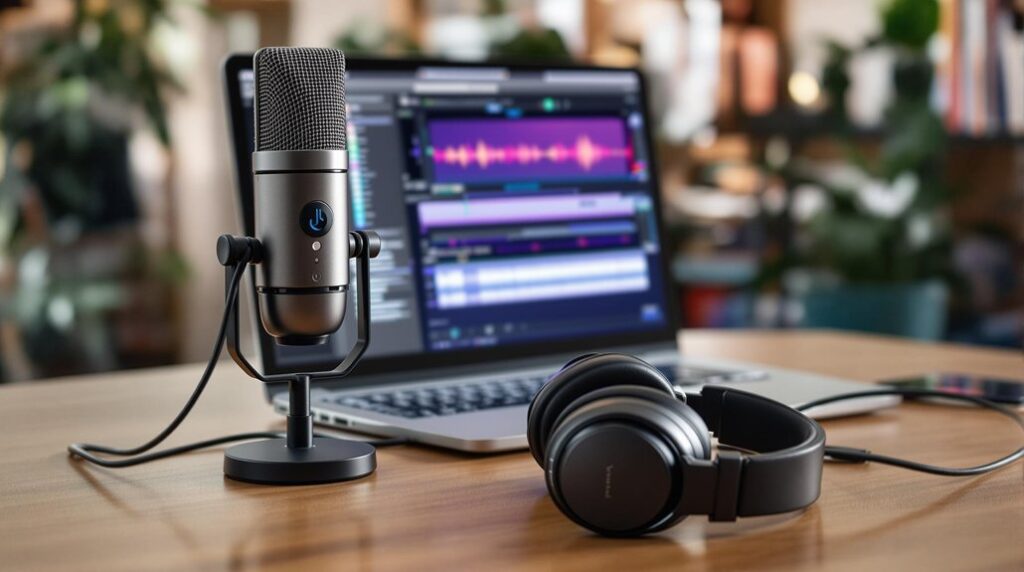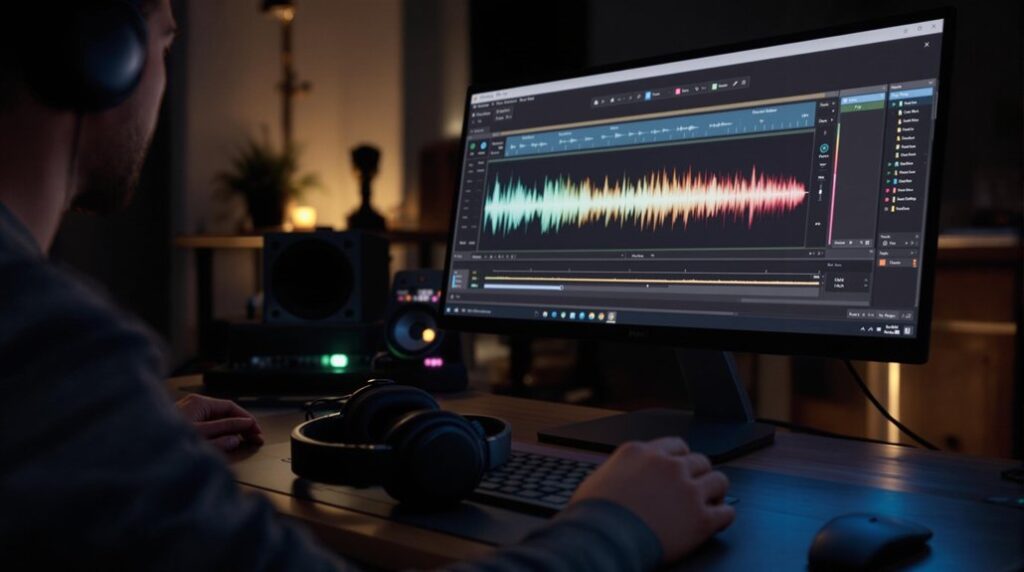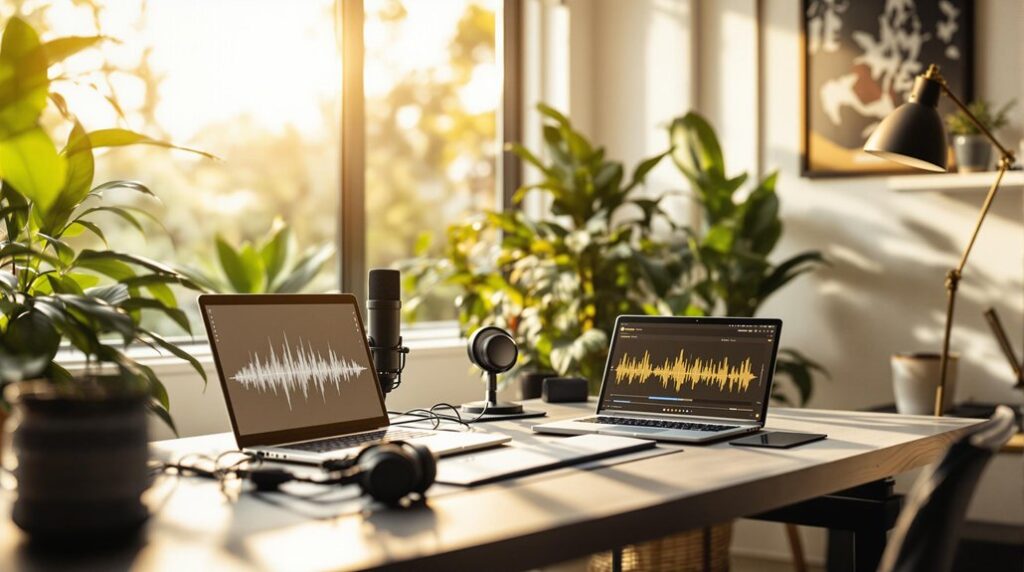To effectively remove echo in Audacity, start with Noise Reduction to minimize background noise. Next, apply the Dereverb plugin to eliminate residual reverb. Utilize the Noise Gate to maintain dynamic range, adjusting the threshold between -20 to -40 dB for ideal clarity. Fine-tune settings, such as the Wet Level in the Dereverb effect, ideally between 30-85%. Combine these techniques for improved results, and always preview the audio after each adjustment to gauge enhancements. With these foundational steps, you’ll greatly enhance your audio quality, and you’ll soon discover additional methods to further raise your production.
Key Takeaways
- Start by applying Noise Reduction to minimize background noise and echo, adjusting settings to achieve 12-24 dB reduction for effective results.
- Use the Dereverb plugin to further eliminate remaining reverb, adjusting the Wet Level between 30-85% for optimal clarity.
- Set a Noise Gate with a threshold between -20 to -40 dB to maintain dynamic range after initial noise reduction.
- Employ a multi-pass approach, previewing audio after each adjustment to ensure clarity and intelligibility throughout the process.
- Regularly reassess and fine-tune parameters to achieve the desired audio quality consistently across the entire track.
Importance of Echo Removal
When you record audio, removing echo is crucial for enhancing the clarity of dialogue and vocals. Excessive echo can detract from intelligibility, making it harder for listeners to grasp your content. This can lead to listener fatigue and discomfort, ultimately diminishing engagement.
Effective echo removal not only improves audio quality but also enhances the professional image of your productions. Echo-free audio recordings prevent muddiness in the final mix, allowing for a cleaner sound that highlights key messages. Additionally, understanding reverb time (RT60) can help you effectively assess and address echo issues in your recordings.
Methods for Echo Reduction
Effective echo removal requires a variety of methods to achieve excellent audio clarity. You can start with Noise Reduction by selecting your audio clip, accessing the effect, and using the “Get Noise Profile” feature. Additionally, applying a Noise Gate helps eliminate background noise during quieter segments by setting a threshold between -20 to -40 dB. For targeted reverb control, the Dereverb Plugin allows you to adjust the Wet Level and Room Size effectively. Using CrumplePop EchoRemover can also simplify the process by automatically detecting and removing echo. Finally, consider using multiple passes to refine your settings for peak echo reduction without sacrificing audio quality.
Integrating techniques such as Noise Reduction can significantly enhance the overall audio quality.
| Method | Key Adjustment | Purpose |
|---|---|---|
| Noise Reduction | Adjust Noise Reduction and Sensitivity | Remove unwanted background noise |
| Noise Gate | Set Gate Threshold (-20 to -40 dB) | Eliminate noise in quiet parts |
| Dereverb Plugin | Wet Level (30-85%), Room Size (5-20 m²) | Reduce reverb effectively |
| CrumplePop EchoRemover | Automatic echo detection | Simplify echo removal |
Using Noise Reduction Effect
How can you achieve significant echo reduction in your audio recordings? Start by utilizing the Noise Reduction effect in Audacity.
Follow these steps:
- Select the audio clip with echo, then navigate to Effect > Noise Reduction and click “Get Noise Profile.”
- Adjust the Noise Reduction slider between 12-24 dB and set Sensitivity to 4-6.
- Modify the frequency smoothing setting from 0 to 300 Hz to effectively minimize background noise.
After fine-tuning these settings, apply the changes to your entire audio track. Remember to enable Stereo Mix in your sound settings for a more integrated audio experience.
If the volume decreases, consider amplifying the audio. Remember, experimenting with these parameters is essential, as different audio clips may require unique configurations for ideal echo removal, ensuring a cleaner, more professional sound.
Utilizing Noise Gate
After addressing background noise with the Noise Reduction effect, the next step in improving audio quality is utilizing the Noise Gate. To begin, access your audio track, select the entire clip, and navigate to Effect > Noise Removal and Repair > Noise Gate.
Adjust the Gate Threshold slider typically between -20 dB and -40 dB. Recommended settings for ideal performance include:
| Setting | Recommended Value |
|---|---|
| Gate Threshold | -40 dB |
| Frequencies | 500 Hz |
| Attack/Hold/Decay | 50 ms / 500 ms / 750 ms |
Experimenting with these parameters enhances echo reduction while minimizing background noise. Applying the Noise Gate effect across the entire audio track guarantees consistent results, so confirm adjustments before exporting your modified audio. Additionally, consider how consistent background noise can affect your adjustments, as it is usually more effectively reduced than irregular sounds.
Employing Dereverb Plugin
To effectively use the Dereverb plugin in Audacity, you’ll first need to install it into the plugins folder and access it via the Effect menu after rescanning.
Once it’s set up, you can adjust the sensitivity settings and fine-tune output quality to match your audio needs. This allows for a tailored approach to reducing unwanted reverb while maintaining the integrity of your recordings.
Plugin Installation Steps
Once you’ve sourced the Dereverb plugin from a reliable website, you can begin the installation process by extracting the files, if necessary.
Follow these steps for successful plugin installation:
- Place the Dereverb plugin files into Audacity’s plugins folder, typically located in the Audacity installation directory.
- Open Audacity and navigate to Effect > Add / Remove Plug-ins to access the Plugin Manager.
- In the Plugin Manager, locate the Dereverb plugin and enable it by checking the box next to its name.
After enabling, you can apply the Dereverb effect by selecting your audio track and choosing Dereverb from the Effects menu.
This process guarantees you effectively integrate the Dereverb plugin into your Audacity workflow for echo removal.
Adjusting Sensitivity Settings
When you access the Dereverb plugin in Audacity, you’ll find that adjusting the sensitivity settings is essential for effectively managing echo in your audio. The Sensitivity slider determines the plugin’s responsiveness to reverb detection. Start with a setting around 50% for best results and adjust based on your audio content. Higher settings yield aggressive reverb reduction, while lower values preserve a more natural sound.
| Sensitivity Level | Reverb Reduction (%) | Expected Outcome |
|---|---|---|
| 30% | 20% | Subtle reverb retention |
| 50% | 30% | Balanced sound |
| 70% | 40% | Noticeable echo removal |
| 90% | 50% | Aggressive reverb reduction |
Experiment with these combinations to maintain the integrity of the original audio.
Fine-tuning Output Quality
While employing the Dereverb plugin in Audacity, fine-tuning the output quality is crucial for achieving a polished audio result. The plugin’s multi-band gate allows precise control over reverb, enhancing your audio track considerably.
Here are key adjustments to evaluate:
- Sensitivity: Adjust this setting to accurately detect reverb levels, guaranteeing clarity.
- Reverb Reduction: Balance the reduction to maintain a natural sound while minimizing echo.
- Wet Level: Set this between 30-85% to control the extent of reverb reduction applied.
For advanced customization, utilize the Expert Mode to tweak Attack and Release settings.
These adjustments guarantee that the DeReverb plugin delivers peak output quality, transforming your audio track into a professional-sounding piece.
Advanced Echo Removal Techniques
To achieve superior echo removal in Audacity, you can leverage advanced techniques that enhance audio clarity without compromising quality.
Start by downloading the Dereverb plugin, which allows for precise echo cancellation by adjusting settings like Wet Level and Room Size. Engaging expert mode lets you modify Attack and Release for tailored reverb reduction.
Consider using the CrumplePop EchoRemover for automatic detection, simplifying your workflow. Additionally, applying echo removal techniques in multiple passes can yield better results, fine-tuning sliders for ideal audio quality preservation.
Don’t forget to combine effects like Noise Reduction and the Noise Gate effect, effectively reducing background noise from audio while ensuring clarity is maintained throughout the process. Furthermore, utilizing EQ adjustments during the echo removal process can help enhance the overall sound quality.
Combining Techniques for Best Results
To achieve ideal echo removal in Audacity, you should consider employing a multi-pass approach that allows for precise adjustments. Combining techniques like Noise Reduction with a Noise Gate and fine-tuning parameters such as Gate Threshold and Sensitivity can greatly enhance your audio’s clarity. Additionally, integrating EQ adjustments with Dereverb targets specific frequencies, further refining your results. Furthermore, utilizing high-quality audio restoration software can provide additional tools for enhancing audio fidelity during the restoration process.
Multiple Pass Echo Reduction
Achieving ideal echo reduction in Audacity often requires a strategic approach that combines multiple passes of different techniques.
To enhance the quality of your recordings, consider these steps:
- Start with a Noise Reduction pass to decrease background noises and reduce echo.
- Apply Dereverb to specifically target any remaining reverb, ensuring a cleaner sound.
- Use the Noise Gate feature after Noise Reduction to maintain dynamic range while further reducing echoes.
Between each pass, adjust parameters slightly to avoid over-processing, which can compromise clarity and introduce artifacts.
Always preview the audio to confirm that each adjustment improves clarity and intelligibility without sacrificing the natural quality of your recordings.
This careful, methodical approach maximizes your echo reduction efforts.
Effect Combination Strategies
While echo removal can be a challenging task, effectively combining various audio processing techniques can yield greatly better results.
Start by applying Noise Reduction to target unwanted noise, followed by the Noise Gate to eliminate residual sounds between segments. Adjust the Gate Threshold and Level Reduction settings for ideal effect.
Then, use the Dereverb plugin to address specific frequency bands, enhancing clarity and further improving echo removal.
It’s crucial to apply these effects in multiple passes, allowing for fine-tuning to maintain audio quality.
Remember to select the entire audio clip before processing to guarantee consistent results throughout the track.
This strategic combination of techniques can considerably raise your audio clip’s overall quality and clarity.
Fine-Tuning Parameter Adjustments
Combining various audio processing techniques effectively sets the stage for fine-tuning parameter adjustments that can optimize echo removal.
To achieve the best results, focus on:
- Dereverb Plugin: Adjust the Wet Level between 30-85% to reduce reverb without losing clarity.
- Noise Gate: Experiment with the Gate Threshold typically set between -20 to -40 dB to attenuate background noise and echo.
- Noise Reduction: Fine-tune settings to a 12-24 dB reduction and sensitivity of 4-6 for effective echo removal while preserving vocal intelligibility.
Alternative Echo Removal Tools
When you’re looking for effective alternatives to Audacity for echo removal, several tools stand out due to their specialized features and user-friendly interfaces.
Wondershare Filmora utilizes AI-powered noise removal to eliminate background sounds, making it ideal for professional audio and video projects.
CrumplePop EchoRemover, a dedicated plugin, automatically detects echo in audio recordings, streamlining your workflow.
HitPaw Univd employs deep learning technology for one-click audio restoration, effectively removing interference across various formats.
EaseUS Vocal Remover offers AI algorithms to separate vocals and music, supporting sizeable audio files without downloads.
Finally, Adobe Audition provides advanced noise reduction and reverb removal tools, giving professional audio engineers precise control over audio quality for best results. These tools are crucial for preserving audio integrity in various applications, including music and film production.
Community Insights and Tips
As you navigate the complexities of echo removal in Audacity, engaging with online communities can greatly enhance your understanding and effectiveness.
Here are three key insights from community discussions:
- Experiment with various noise reduction settings and noise gate effects to tailor echo removal techniques to your audio’s unique characteristics.
- Utilize custom presets shared by the Audacity community as a foundation, saving you time while boosting clarity of the audio.
- Apply multiple passes of echo removal for improved outcomes, which helps minimize artifacts and enhances final sound quality.
Additionally, consider using high-pass and low-pass filters to further refine your audio and effectively manage unwanted reverberations.
Regularly updating Audacity guarantees you benefit from the latest features, further refining your echo removal efforts.
Frequently Asked Questions
Is There a Way to Remove Echo From Audio?
Yes, you can remove echo from audio by employing effective audio editing techniques. Use noise reduction and various audio effects to enhance sound quality, ensuring vocal clarity in your digital audio recordings for professional results.
What Software Removes Echo?
For effective echo removal, consider audio editing software like Audacity, which employs echo cancellation techniques, or use advanced AI tools like Wondershare Filmora. Implement noise reduction methods and sound recording tips to enhance voice clarity during audio mixing.
How Do You Echo Out in Audacity?
To echo out in Audacity, adjust echo settings using noise reduction for improved audio clarity. Employ sound editing techniques and recording tips for vocal enhancement, ensuring ideal results in your digital audio projects. Experiment and fine-tune settings.
How to Get Rid of Reverb in Audacity?
To reduce reverb in Audacity, use reverb reduction techniques with plugins. Focus on audio editing tips like adjusting Wet Levels for sound quality improvement, ensuring vocal clarity enhancement through effective digital audio processing in your recording environment setup.
Conclusion
To summarize, effectively removing echo in Audacity is achievable through various methods, including noise reduction, noise gating, and dereverb plugins. By understanding and applying these techniques, you can greatly enhance audio clarity. Experimenting with combinations of these tools often yields the best results. Additionally, exploring alternative tools can further refine your audio quality. With practice and patience, you’ll master echo removal, ensuring your recordings sound professional and polished.




